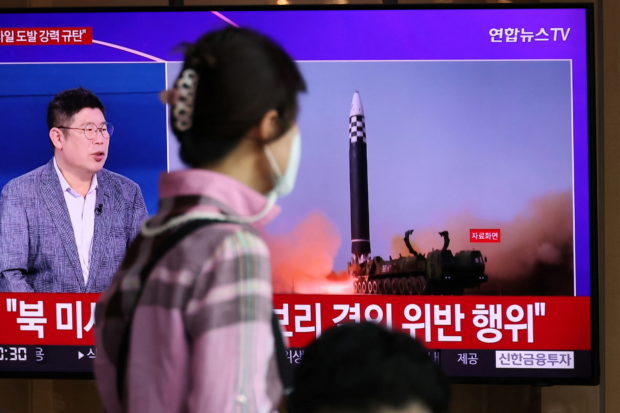
A woman watches a TV broadcasting a news report on North Korea’s launch of three missiles what appeared to have involved an intercontinental ballistic missile (ICBM), in Seoul, South Korea, May 25, 2022. REUTERS/Kim Hong-Ji
SEOUL — North Korea fired three missiles, including one thought to be an intercontinental ballistic missile (ICBM) on Wednesday, after U.S. President Joe Biden left Asia following a trip in which he agreed to new measures to deter the nuclear-armed state.
South Korea’s Joint Chiefs of Staff (JCS) said the three missiles were fired in less than an hour from the Sunan area of the North’s capital, Pyongyang, where its international airport has become a hub of missile tests.
The first missile launched on Wednesday appeared to be an ICBM, while a second unidentified missile appears to have failed mid-flight, the JCS said. The third missile was a short-range ballistic missile (SRBM), it said.
In response, the United States and South Korea held combined live-fire drills, including surface-to-surface missile tests involving the Army Tactical Missile System (ATACMS) of the U.S. and the South’s Hyunmoo-2 SRBM, both militaries said.
“Our military’s show of force was intended to highlight our resolve to firmly respond to any North Korean provocations, including an ICBM launch, and our overwhelming capability and readiness to conduct a surgical strike on the origin of the provocation,” the JCS said in a statement.
North Korea has conducted a flurry of missile launches this year, from hypersonic weapons to test firing its largest ICBMs for the first time in nearly five years. It also appears to be preparing for what would be its first nuclear test since 2017.
U.S. and South Korean officials had recently warned that North Korea appeared ready for another weapons test, possibly during Biden’s visit, which was his first trip to Asia as president and included a summit with South Korean President Yoon Suk-yeol in Seoul.
Yoon, who took office on May 10, convened his first meeting of the national security council, which strongly condemned the latest launch as a “grave provocation,” especially as it came before Biden returned home.
Yoon ordered the aides to strengthen the U.S. extended deterrence and combined defence posture as agreed with Biden, his office said.
“North Korea’s continued provocations will only result in even stronger, faster South Korea-U.S. deterrence, and bring deeper isolation upon itself,” Yoon’s government said in a separate statement.
A White House official said that Biden, who departed Japan on Tuesday evening, had been briefed on the launches and would continue to receive updates.
South Korean Foreign Minister Park Jin and U.S. Secretary of State Antony Blinken also agreed to step up diplomatic efforts to reinforce extended deterrence and facilitate a new U.N. sanctions resolution in a phone call, Seoul’s ministry said.
“We call on the DPRK to refrain from further provocations and engage in sustained and substantive dialogue,” a State Department spokesperson said, using the initials of North Korea’s official name.
Show of force
Pyongyang resumed ICBM testing in late March, ending its self-imposed 2017 moratorium on long-range missile and nuclear testing, amid stalled denuclearization talks with Washington.
In Wednesday’s test, the suspected ICBM flew 360 km (223.7 miles) to a maximum altitude of 540 km, while the SRBM flew 760 km to a maximum altitude of 60 km, the JCS said.
Japan reported at least two launches, one of which flew about 300 km and reached a maximum altitude of 550 km, and the other to the distance of about 750 km (465 miles) and a maximum altitude of 50 km, Japan’s defence minister said.
Japanese broadcaster NHK said the missiles appeared to have fallen outside Japan’s exclusive economic zone (EEZ).
Japanese chief cabinet secretary Hirokazu Matsuno said the North could take more provocative actions, including a nuclear test.
The U.S. military’s Indo-Pacific Command said it was aware of “multiple” launches. They highlighted the “destabilising impact of the DPRK’s illicit weapons programme” but did not pose an immediate threat.
In Seoul over the weekend, Biden and Yoon agreed to hold bigger military drills and deploy more U.S. strategic assets if necessary to deter North Korea’s intensifying weapons tests.
But they also offered to send COVID-19 vaccines to North Korea as the isolated country battles its first confirmed outbreak, and called on Pyongyang to return to diplomacy.
There had been no response from Pyongyang to the diplomatic overtures or offers of aid, Biden said at the time.
The waning hours of Biden’s visit to the region also saw Russian and Chinese bombers flying joint patrols near Japanese and South Korea air defense zones on Tuesday in a pointed farewell.
RELATED STORY:
Biden heads to Japan after warning on North Korea threat
Biden greets Kim, but says US ‘prepared’ for North Korea weapons test